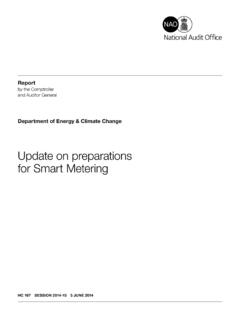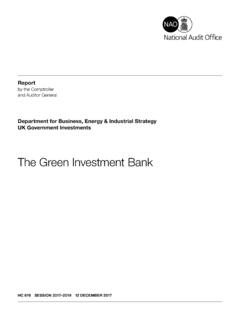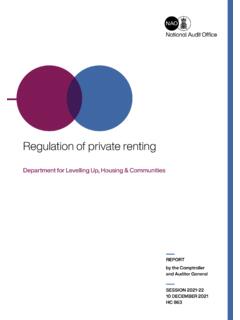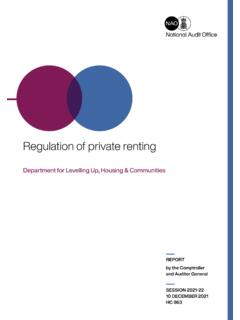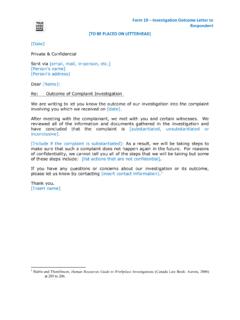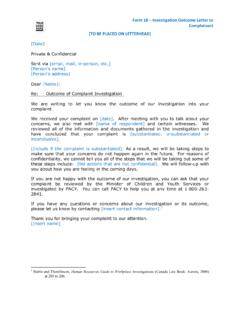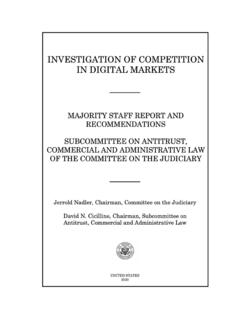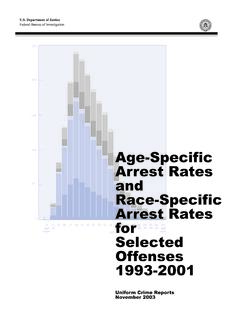Transcription of Investigation WannaCry cyber attack and the NHS (Summary)
1 A picture of the National Audit Office logo Report by the Comptroller and Auditor General Department of Health Investigation : WannaCry cyber attack and the NHS. HC 414 SESSION 2017 2019 25 APRIL 2018. Our vision is to help the nation spend wisely. Our public audit perspective helps Parliament hold government to account and improve public services. The National Audit Office scrutinises public spending for Parliament and is independent of government. The Comptroller and Auditor General (C&AG), Sir Amyas Morse KCB, is an Officer of the House of Commons and leads the NAO. The C&AG certifies the accounts of all government departments and many other public sector bodies. He has statutory authority to examine and report to Parliament on whether departments and the bodies they fund have used their resources efficiently, effectively, and with economy.
2 Our studies evaluate the value for money of public spending, nationally and locally. Our recommendations and reports on good practice help government improve public services, and our work led to audited savings of 734 million in 2016. Department of Health Investigation : WannaCry cyber attack and the NHS. Report by the Comptroller and Auditor General Ordered by the House of Commons to be printed on 24 April 2018. This report has been prepared under Section 6 of the National Audit Act 1983 for presentation to the House of Commons in accordance with Section 9 of the Act Sir Amyas Morse KCB. Comptroller and Auditor General National Audit Office 24 October 2017. HC 414 | This report investigates the NHS's response to the cyber attack that affected it in May 2017 and the impact on health services.
3 Investigations We conduct investigations to establish the underlying facts in circumstances where concerns have been raised with us, or in response to intelligence that we have gathered through our wider work. National Audit Office 2018. The material featured in this document is subject to National Audit Office (NAO) copyright. The material may be copied or reproduced for non-commercial purposes only, namely reproduction for research, private study or for limited internal circulation within an organisation for the purpose of review. Copying for non-commercial purposes is subject to the material being accompanied by a sufficient acknowledgement, reproduced accurately, and not being used in a misleading context. To reproduce NAO copyright material for any other use, you must contact Please tell us who you are, the organisation you represent (if any) and how and why you wish to use our material.
4 Please include your full contact details: name, address, telephone number and email. Please note that the material featured in this document may not be reproduced for commercial gain without the NAO's express and direct permission and that the NAO reserves its right to pursue copyright infringement proceedings against individuals or companies who reproduce material for commercial gain without our permission. Links to external websites were valid at the time of publication of this report. The National Audit Office is not responsible for the future validity of the links. 11594 04/18 NAO. Contents What this Investigation is about 4. Summary 5. Part One The impact of the cyber attack 11. Part Two Why some parts of the NHS were affected 16.
5 Part Three How the Department and the NHS responded 21. Appendix One Our investigative approach 28. Appendix Two Trusts infected or disrupted by WannaCry 30. The National Audit Office study team consisted of: Finnian Bamber, Alex Bowyer, Nigel Leung, Francisca Lopes, Linda Mills and David Williams, under the direction of Robert White. This report can be found on the National Audit Office website at For further information about the National Audit Office please contact: National Audit Office Press Office 157 197 Buckingham Palace Road Victoria London SW1W 9SP. Tel: 020 7798 7400. Enquiries: Website: Twitter: @NAOorguk If you are reading this document using a screen reader you may wish to use the bookmarks to navigate around this document.
6 4 What this Investigation is about Investigation : WannaCry cyber attack and the NHS. What this Investigation is about 1 On Friday 12 May 2017 a global ransomware attack , known as WannaCry , affected more than 200,000 computers in at least 100 countries. In the UK, the attack particularly affected the NHS, although it was not the specific target. At 4 pm on 12 May, NHS England declared the cyber attack a major incident and implemented its emergency arrangements to maintain health and patient care. On the evening of 12 May a cyber security researcher activated a kill-switch so that WannaCry stopped locking devices. 2 According to NHS England, the WannaCry ransomware affected at least 80 out of the 236 trusts across England, because they were either infected by the ransomware or turned off their devices or systems as a precaution.
7 A further 603 primary care and other NHS organisations were also infected, including 595 GP practices. 3 Before the WannaCry attack the Department of Health (the Department) and its arm's-length bodies had work under way to strengthen cyber -security in the NHS. For example, NHS Digital was broadcasting alerts about cyber threats, providing a hotline for dealing with incidents, sharing best practice and carrying out on-site assessments to help protect against future cyber attacks; and NHS England had embedded the 10 Data Security Standards (recommended by the National Data Guardian) in the standard NHS. contract for 2017-18 and was providing training to its Board and local teams to raise awareness of cyber threats. In light of the WannaCry attack , the Department announced further plans to strengthen NHS organisations' cyber -security.
8 4 Our Investigation focuses on events immediately before 12 May 2017 and up until 30 September 2017. We only cover the effect the WannaCry attack had on the NHS in England. We do not cover how the WannaCry attack affected other countries or organisations outside the NHS. A cyber attack on either the health or social care sectors could cause disruption across the whole health and social care sector. For example, the Care Quality Commission (CQC) told us that, as some trusts were unable to communicate with social services, there could have been delays in the discharge of patients from hospital to social care, although the CQC relayed advice from NHS. Digital and NHS England to social care providers to help manage any disruption. This Investigation sets out the facts about: the ransomware attack 's impact on the NHS and its patients.
9 Why some parts of the NHS were affected; and how the Department and NHS national bodies responded to the attack . Investigation : WannaCry cyber attack and the NHS Summary 5. Summary 1 The WannaCry attack affected NHS services in the week from 12 May to 19 May 2017. The Department of Health (the Department) and NHS England worked with NHS Digital, NHS Improvement, the National cyber Security Centre, the National Crime Agency and others to respond to the attack . Key findings The risk of a cyber attack affecting the NHS. 2 WannaCry was the largest cyber attack to affect the NHS, although individual trusts had been attacked before 12 May 2017. For example, two of the trusts infected by WannaCry had been infected by previous cyber attacks. One of England's biggest trusts, Barts Health NHS Trust, had been infected before, and Northern Lincolnshire and Goole NHS Foundation Trust had been subject to a ransomware attack in October 2016, leading to the cancellation of 2,800 appointments (paragraph and Figure 5).
10 3 The Department was warned about the risks of cyber attacks on the NHS a year before WannaCry and although it had work under way it did not formally respond with a written report until July 2017. The Secretary of State for Health asked the National Data Guardian and the Care Quality Commission (CQC) to undertake reviews of data security. These reports were published in July 2016 and warned the Department that cyber attacks could lead to patient information being lost or compromised and jeopardise access to critical patient record systems. They recommended that all health and care organisations needed to provide evidence that they were taking action to improve cyber -security, including moving off old operating systems. Although the Department and its arm's-length bodies had work under way to improve cyber -security in the NHS, the Department did not publish its formal response to the recommendations until July 2017 (paragraphs and ).

